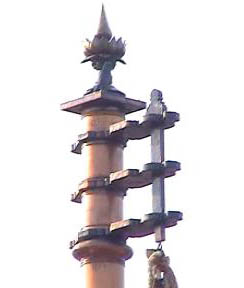
Ayyavazhi is a henotheistic belief that originated in South India. It is cited as an independent monistic religion by several newspapers, government reports, journals, and academic researchers. In Indian censuses, however, the majority of its followers declare themselves as Hindus. Thus, Ayyavazhi is also considered a Hindu denomination. Officially (legally), it exists within Hinduism as a Hindu denomination.

Akilathirattu Ammanai, also called Thiru Edu, is the main religious text of the Tamil belief system Ayyavazhi. The title is often abbreviated to Akilam or Akilathirattu.

Pathi is the name of the primary centres of congregational worship for the South Indian religious system of Ayyavazhi, having a relatively large structure like that of a temple. They are seven in number.

Dharma Yukam is the state of absolute bliss as per Ayyavazhi mythology. Dharma Yukam is described in the Akilam seventeen in Akilattirattu Ammanai. It is related to Dharmic moksha and to Abrahamic heaven.

The Arul Nool is a supplement to the Akilattirattu Ammanai, and is likewise considered a holy scripture of Ayyavazhi. This book contains the collection of messages given by Ayya Vaikundar to his Disciples, whose names are unknown. Since they are believed to be composed by Arylalarkar, it acquired the name Arulnool. There is no direct indication within the book regarding the time of its composition.
According to Akilattirattu Ammanai, the scripture of the Ayyavazhi religion, Ayya Vaikundar, the Incarnation of Lord Narayana in Kali Yukam, has five Seedar (disciples). They were in the previous Dwapara Yukam as Pandavas who were transmigrated as disciples of Vaikundar in this Yuga.
The following outline is provided as an overview and topic guide to Ayyavazhi:

Ayyavazhi theology is the theology of a South Indian religious Faith and officially a sect of Hinduism known as Ayyavazhi. Several fundamental theological beliefs distinguish the Ayyavazhi tradition from Hinduism.

The Ayyavazhi includes a corpus of teachings of its initiator Ayya Vaikundar in the form of instructions and slogans found in the religious book Akilattirattu.

According to the Ayyavazhi religion, the Ayyavazhi Trinity is the incarnation of God in the current stage of world development. Ayya Vaikundar, the Incarnation, is the combination of the Ultimate God, Narayana, and Human Being. In Akilam immediately after the Incarnation of Vaikundar, he was viewed simultaneously as the Ultimate God, Narayana, and as son of Narayana. As per the earlier deed Narayana had to destroy Kaliyan, but due to the boons that kaliyan claimed Narayana cannot destroy him. And as per the promise made by Kaliyan, he would only be destroyed, if he give torture to any Pantaram. To overcome all these, such a unique way of Incarnation was planned.

The Ayyavazhi symbolism deals with the symbols which are used in or used to represent Ayyavazhi. Though Akilam the scripture of Ayyavazhi does not point out any symbol directly, there are a few symbols which are used for representing Ayyavazhi which came into practice gradually.

The purpose of this chronology is to give a detailed account of Ayyavazhi from the beginning of the incarnational events of Vaikundar to the present time. Question marks on dates indicate approximate dates. A star (*) indicates the mentioning of that particular date in Akilam or Arul Nool. All dates but a few are found in the Tamil calendar and so doesn't coincide exactly with the months of the Gregorian calendar. The dates may span over any halves of the two consecutive months (Gregorian).

Muthiri Kinaru is the sacred well located in the north-western corner of Swamithoppe village. This is the famous theertha of the temple. It is located half a kilometre west from the main Pathi.

The Inclusiveness and exclusivity in Ayyavazhi is the inclusive and exclusive ideology of Ayyavazhi scriptures over other religions. The formula of inclusivism and exclusivism was applied in the religio-cultural universe of Ayyavazhi is one that is not found anywhere else in the world. Though there are separate verses towards inclusivism and exclusivism as central themes in Akilam, the mixture of both is unique. The inclusivistic theory of accepting the views of different religions for a certain period of time and from then onwards exclusivistically rejecting all of them by narrating that all the previous had lost their substances is a mythical as well as religious break-through.

The Akilathirattu Ammanai the scripture of Ayyavazhi teaches Dharma on two different perspective. One in sociology as charity and truth and another under spirituality to attain the stage of Oneness, unified into Lord Vaikundar. This state of ultimate oneness is called as Dharma Yukam or Dharma Pathi. Akilam also says that, Dharma is the only living wheel. The sociological way is asked to be followed by every one to attain the spiritual state of Dharma.

Ayyavazhi phenomenology is the phenomenological variations found in Ayyavazhi society, worship centers etc. from their holy text Akilattirattu Ammanai.

Ayyavazhi is a belief system originating from South India, which advocates that Ayya Vaikundar is an incarnation of Narayana, based on its religious scripture Akilattirattu Ammanai. Some of its core believers advocate that Ayyavazhi is a religion in itself, whereas others believe that it is a sect within Hinduism. The path of Akilam is also viewed as a renaissance of Hinduism which regenerates and organises the ideas of all Hindu scriptures. But on the other hand it acts as an agent of reformation in the nineteenth century Tamil and Malayalam Society.
Vivekanandan Version is one among the release versions of Akilam. It was the only version released so far which includes the original source-text as well as the interpretations combainingly. It was named after the publication Vivekananada Pathippakam.
Vaikundar Thirukkudumbam Version (VTV) is one among the released versions of Akilam, the scripture of Ayyavazhi. It was named after the socio-religious welfare organisation Ayya Vaikundar Thirukkudumbam, which released it.

There are a good number of publications in Ayyavazhi. Most of them are in Tamil and few in Malayalam and very few in English.



